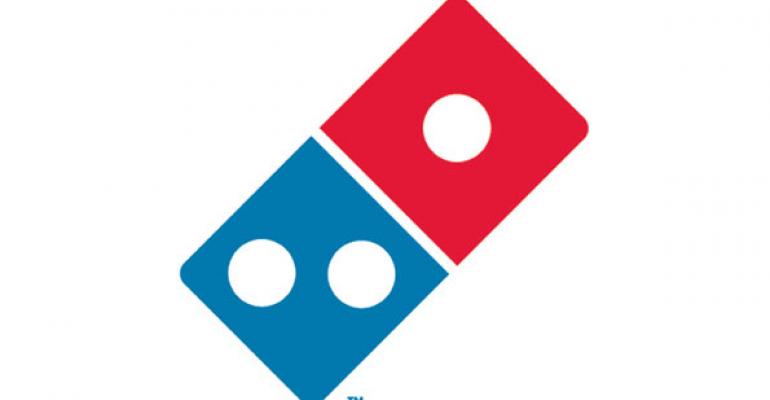Domino’s Pizza officials said the key word behind the company’s 17.6-percent growth in net income for the third quarter was “consistency,” as growth in transactions and average check powered domestic results and international expansion continued apace.
For the Sept. 9-ended third quarter, Ann Arbor, Mich.-based Domino’s reported net income of $26 million, or 43 cents per diluted share, compared with $22.1 million, or 35 cents per diluted share, a year earlier.
Revenue grew 0.5 percent for the quarter to $378 million, reflecting increases in same-store sales domestically and abroad, as well as robust new-store development in its international business, partially offset by corporate-store sales lost to a 2011 franchisee acquisition and a negative effect from foreign-currency translation.
RELATED
• IT in 3: Domino's Pizza CIO discusses IT strategy
• Analyst: Domino's could turn Pizza Hut's share of pan pie into profit
• More restaurant industry finance news
Same-store sales rose 3.3 percent in the United States, comprising gains of 0.5 percent for corporate stores and 3.6 percent for franchised locations. International same-store sales grew 5 percent.
A bigger slice of the market
Transaction counts and the average check both grew in the third quarter, officials said, as Domino’s pivoted from advertising side items, which have higher margins for franchisees but do not drive traffic, to pizzas, which do tend to spur more orders.
“Clearly, there’s got to be some balance, because selling sides are good for profitability at the store level, and ultimately that will generate better returns for franchisees, which will generate some store growth,” Doyle said. “But in general, when we talk about promoting pizza, you’re going to see a little bit more on the order count side.”
Doyle added that Domino’s has added market share in the past few years, taking it mostly from independents and regional chains. Domino’s and its two main national competitors, Pizza Hut and Papa John’s Pizza, always had the advantages of scale, national advertising and franchise systems to cut into that market share, he said, but those gains have accelerated since the recession in large part because the big three are investing so much in technology.
“I would have expected more share gains over time than we saw, because over the course of a couple decades, there hadn’t been much share movement toward national players,” he said. “Now you’ve seen it for six to eight quarters in a row … and some of it may have been the economic environment, where the financial strength of the national players and their franchisees allowed them to come through it more aggressively, and the other part of it is technology.”
One-third of Domino’s sales in the United States comes from digital ordering, including 40 percent of all delivery sales. “It’s creating a better customer experience, and that gives us efficiencies,” Doyle said. “It’s difficult for a regional or smaller player to put together a platform like we have.”
Regarding Domino’s flexibility in 2013 to raise menu prices or ease off aggressive discounts to keep pace with Pizza Hut and Papa John’s, “the consumer decides that more than the competitive situation,” Doyle said. “We’re seeing a consumer very careful with how they’re spending their money, and we have to give them a good value. We don’t see a whole lot of room on pricing out there.”
An opening for more store growth
Having just reached the 10,000-store milestone with an opening in Turkey in September, Domino’s is optimistic that international store growth would continue to lead the way in store expansion, though the United States may return to positive net openings in the near future.
On a trailing-12-month basis, Domino’s is on pace to exceed its guidance for as many as 450 international openings, and Doyle said the company remains bullish on international expansion. Domino’s is still waiting for signs of severe weakness to appear, particularly in Europe, but things generally are steady, he said.
“Things have held together nicely, and we’re happy with 5 percent same-store sales growth [abroad],” Doyle said. “Greece was weak, Spain was not great, but the rest has held together. From a store growth standpoint, we track very carefully the payback period on stores around the world, and the best indicator of store growth in the medium term is the ROI on those stores. That continues to be very strong in international and, if anything, getting stronger.”
Doyle acknowledged that “new units are harder to come by in our more mature domestic system,” but he added that Domino’s was encouraged by the fact that the number of net closures has tapered off compared with recent years and that store count growth may be slightly positive for the year. The prototype for new stores announced in August should lay groundwork for profitable expansion in future years, he said, as it is “very a la carte” and allows operators to choose new design features — like grab-and-go cases or a “pizza theater” display kitchen — that make sense for their real estate.
Store-level profits are up “materially” compared with four years ago, Doyle said, which should help franchisees form plans to expand domestically through new stores or acquisitions. However, access to growth capital has improved for large franchisees with 20 or more stores, but smaller operators hoping to add a second or third store still report a difficult lending environment, he said. Domino’s system consists mostly of smaller franchisees, with the average number of stores per operator at four.
Domino’s operates 387 stores and franchises another 4,509 in the United States, and its international system consists of 4,896 restaurants in more than 70 foreign markets.
Contact Mark Brandau at [email protected].
Follow him on Twitter: @Mark_from_NRN





